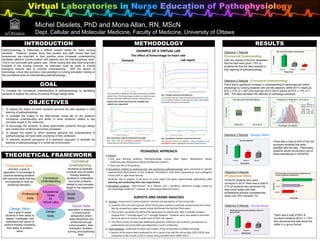Poster_HAPS_2015_May20
- 1. Michel D├®silets, PhD and Mona Allan, RN, MScN Dept. Cellular and Molecular Medicine, Faculty of Medicine, University of Ottawa Virtual Laboratories in Nurse Education of Pathophysiology Educational Goals for Virtual Labs Conceptual Understanding Social Skills Design Skills Professional Skills INTRODUCTION Pathophysiology is historically a difficult subject matter for many nursing students. However, studies show that student and staff nurses feel that biosciences are important to their practice since increased understanding facilitates effective communication with patients and the interdisciplinary team. This in turn promotes safe patient care. While nursing skill labs have long been included in the nursing curricula, an extension must be made to include biological science labs to promote understanding. With the advent of technology, virtual labs provide a new paradigm to nursing simulation training at the conceptual level of understanding pathophysiology. 1. To assess the extent to which students perceive the labs assisted in their learning of pathophysiology. 2. To evaluate the impact of the Web-Human virtual lab on the studentŌĆÖs conceptual understanding and ability to solve problems related to key concepts taught in the classroom. 3. To encourage the studentsŌĆÖ to solve open-ended problems through design and construction of abnormal human processes. 4. To assess the extent to which students perceive the understanding of pathophysiology will have when practicing in their profession. 5. To examine students perception of a teamwork approach to facilitate the learning of pathophysiology in a virtual lab environment. OBJECTIVES GOAL To increase the conceptual understanding of pathophysiology by facilitating students to explore the nature of science through design skills. Objective 1 Results Over the course of the four semesters that the labs were given, 70% of students felt that the labs assisted in their learning of pathophysiology. Objective 3 Results Objective 4 Results Objective 5 Results METHODOLOGY RESULTS THEORETICAL FRAMEWORK Conceptual Understanding envisions to illustrate concepts and principles thereby assisting students to understand and solve problems related to key concepts taught in the classroom. Professional Skills envision a goal of application of knowledge to practice assisting students with technical skills that they are expected to have as practicing clinicians. Social Skills acquisition is based on a constructivist perspective where team behaviours are enhanced through communication, team interaction, problem- solving, and leadership skills. Design Skills has a goal to assist students in their ability to design, investigate, and understand the nature of science thereby increasing their ability to problem- solve. There was a total of 54% of the 222 surveyed students that were satisfied with the labs. Particularly, students would recommend use of these laboratories in PHS4700. Of the 67 students who were surveyed in 2014, there was a total of 51% of students who perceived the labs would assist with their professional practice competencies, while only 19% indicated ŌĆ£noŌĆØ. There was a total of 58% of surveyed students (2014, n = 67) who perceived the labs would be better in a group format. (Professional Skills) (Social Skills) (Design Skills) Objective 2 Results There was a significant increase in understanding of cardiovascular patho- physiology by nursing students with pre-lab sessions (2009-2011) means at 50% ┬▒ 21% (n = 367) and post-lab (2012-2014) means at 67% ┬▒ 17% (n = 360). The data represent the difficulty of cardiology questions. (Conceptual Understanding) (Conceptual Understanding) Positive Negative Neutral 58% 22% 19% Percentage Responses Would labs enhance understanding if done in a group format? Negative Neutral Positive 19% 30% 51% Percentage Response Did virtual labs help me develop competencies as a future healthcare professional? Positive Negative Neutral 54% 24% 22% Percentage Responses Overall Satisfaction Positive Neutral Negative 70% 21% 9% Percentage Responses Did virtual labs faciliate understanding?EXAMPLE OF A VIRTUAL LAB The effect of hemorrhage on heart rate This simulation reproduces the effect of losing 2L of blood within 3 min. The hemorrhage resulted in a rapid increase of heart rate that stabilised at around 100 pulses/min. Explain this increase and show the variables that support your arguments. Fig 1. Changes induced by the blood loss. Loss of blood caused a decrease of preload (red) and stroke volume (green), leading to a decrease of cardiac output (blue) and systemic blood pressure (purple). Lab report Fig2. Homeostatic response following hemorrhage. Both heart rate and peripheral resistance increased, as a compensation for the drop of blood pressure. Fig 3. Sympathetic activation induced by blood loss. The increase of heart rate follows a strong activation of the sympathetic system triggered by the drop in blood pressure. Scenario PEDAGOGIC APPROACH ’ü▒ Classes: ’é¦ 2nd year Nursing students; Pathophysiology course; Main Topics: Metabolism, Blood, Cardiovascular, Respiratory, Renal and Nervous systems ’é¦ Class size: 60 to 90 students. ’ü▒ Simulations related to cardiovascular and pulmonary pathophysiology were presented as specific experimental observations to the students. Simulations used were hypovolemic and cardiogenic shocks (left or right heart failure). Students had to explain in the form of a lab report the given experimental observation after planning and conducting their own experiments. ’ü▒ Simulation program: ŌĆ£web-HumanŌĆØ, by R. Meyers and L. Geoffrion, Skidmore College, based on the physiology model of T. Coleman (U. Mississippi Medical Center). SURVEYS AND EXAMS ANALYSES ’ü▒ Surveys: conducted to assess studentsŌĆÖ interest and perception of the virtual labs. ’é¦ Students from the last 4 groups (2012-2014) were invited to evaluate anonymously the virtual labs by answering a paper-based survey distributed during their final exam. ’é¦ The surveys consisted of 6 MCQs that were given as statements, with 5 possible answers ranging from ŌĆ£I strongly agreeŌĆ£ to ŌĆ£I strongly disagreeŌĆØ. Students were also asked to estimate the time spent (in hours) to write each of their lab reports. ’é¦ The 2014 survey included two additional questions related to the studentsŌĆÖ perceptions on professional and social skills (see Objectives 4 and 5 of Results). ’ü▒ Exam analyses: conducted to assess the impact of the virtual labs on student learning. ’é¦ Results of the exams were analysed for all 4 classes that had the virtual labs (2012-2014) and compared to the results of the 4 classes that preceded them (2009-2011).
